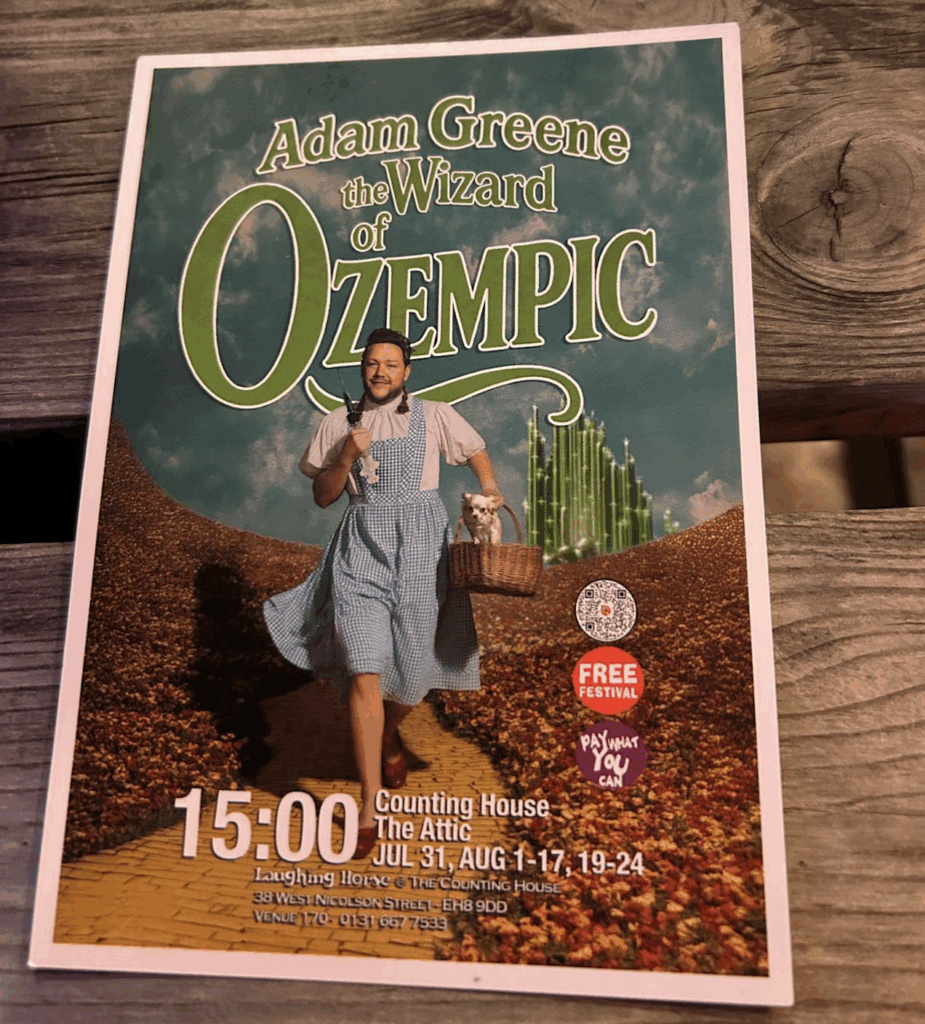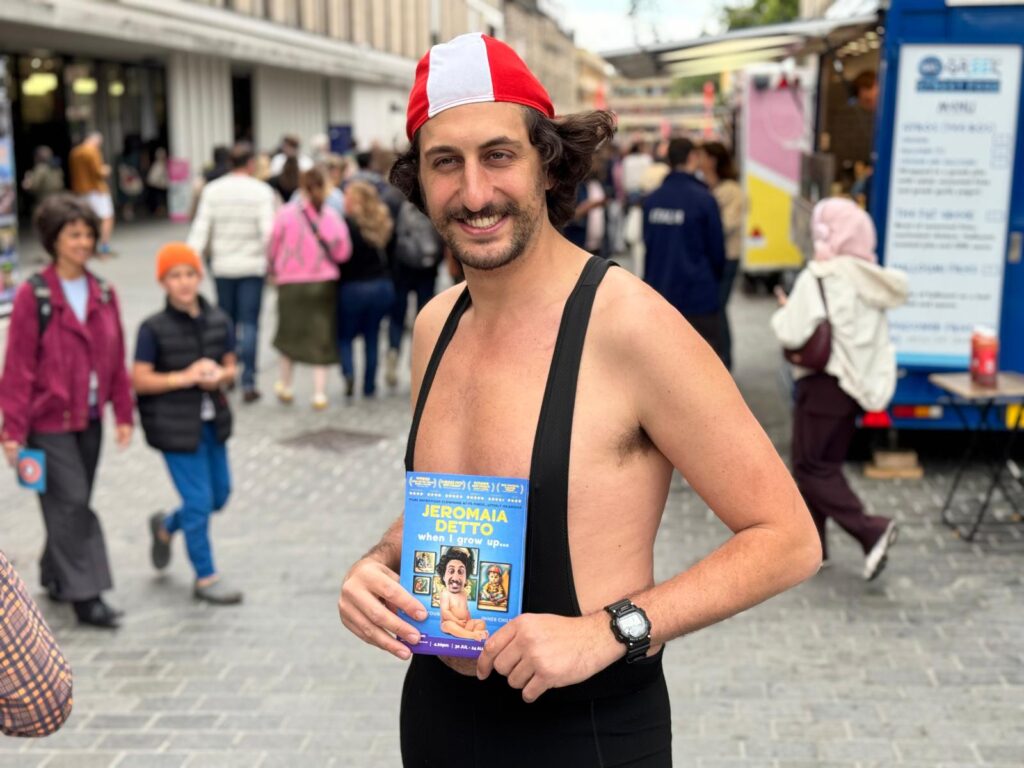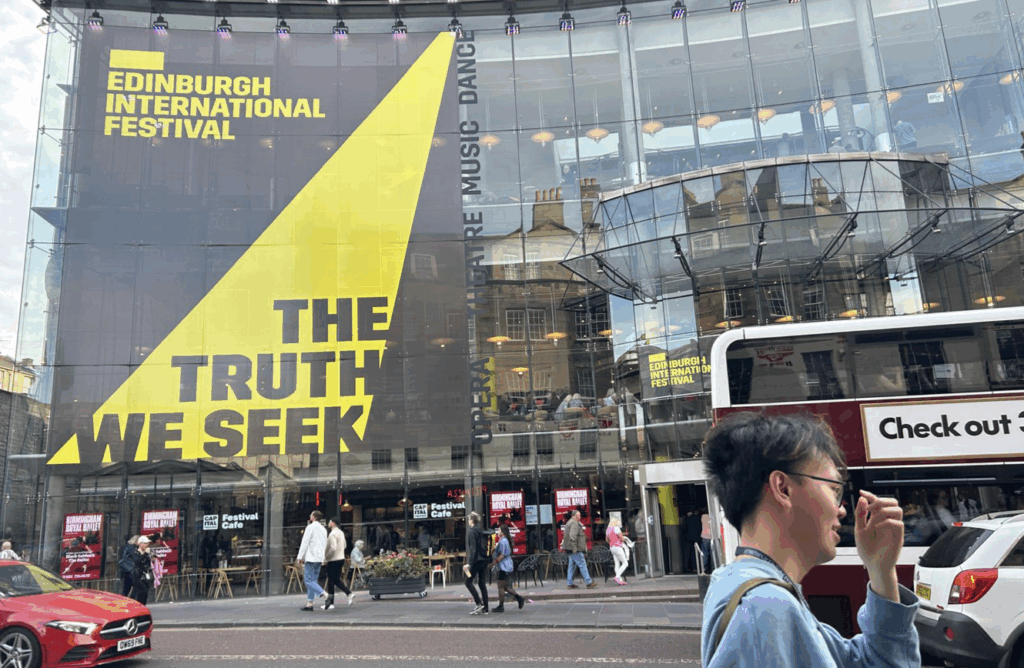With nearly 4,000 shows, all the world’s a stage at Edinburgh Fringe
Description
Every August, the Scottish capital turns into a stage. For three and a half weeks, Edinburgh hosts The Fringe, the world’s largest performing arts festival.
This year’s tally: nearly 4,000 shows, artists from more than 70 countries and genres spanning from improvised magic to Nora Ephron-inspired romcoms and even punk ballet.
<figure class="wp-block-image alignright size-large">
 <figcaption class="wp-element-caption">Comedian Adam Greene leans into wordplay with “The Wizard of Ozempic” — a Fringe show that, he admits, has almost nothing to do with Dorothy, Toto or wizards.Rebecca Rosman/The World</figcaption></figure>
<figcaption class="wp-element-caption">Comedian Adam Greene leans into wordplay with “The Wizard of Ozempic” — a Fringe show that, he admits, has almost nothing to do with Dorothy, Toto or wizards.Rebecca Rosman/The World</figcaption></figure>It’s exhilarating. It’s also overwhelming.
The Pleasance Courtyard is the heart of the action, a makeshift watering hole buzzing with performers and festivalgoers. With so much going on, it’s a wonder how anyone gets noticed.
“Fame helps. Money helps,” London comic Adam Greene said. Without either, you’d better have a “striking title and a great poster.”
Greene’s own flyer features him dressed as Dorothy from “The Wizard of Oz,” Toto in one hand, an Ozempic needle in the other. The title reads: Adam Greene and the Wizard of Ozempic.
At the Fringe, puns go far. So does stamina. Many performers spend hours each day on the pavements, handing out flyers to strangers — sometimes in chicken suits, sometimes while playing harp.
For performers, whether it’s their first festival, or they’re veterans, it’s all about getting noticed. And many go to great lengths to find creative ways to stand out from the rest of the crowd.
Australian clown Jeromaia Detto turned flyering into performance art. In a red-and-white cap and black unitard, he danced, twirled and distributed flyers in mid-spin.
His Fringe show “When I Grow Up” is fast, playful and mirrors his rules for successful flyering: “always be moving, always be smiling, notice everything and, above all — play,” he said.
<figure class="wp-block-image size-large">
 <figcaption class="wp-element-caption">Australian clown Jeromaia Detto, 33, hands out flyers for his show “When I Grow Up” outside Bristo Square. Detto says flyering can bring in half the audience for his shows.Rebecca Rosman/The World</figcaption></figure>
<figcaption class="wp-element-caption">Australian clown Jeromaia Detto, 33, hands out flyers for his show “When I Grow Up” outside Bristo Square. Detto says flyering can bring in half the audience for his shows.Rebecca Rosman/The World</figcaption></figure>The critics and the hype machine
But charm and paper alone won’t fill theaters. Critics can help if performers can catch their eye.
Tim Bano, a theater critic filing this year for the Financial Times, said, starting in April, his inbox fills with hundreds of press releases a day. But once on the ground, even the spreadsheets collapse under the weight of so many shows. “Very quickly, you start relying on word of mouth,” he explained. “What’s the best thing you’ve seen?”
That question circulates across the city, forming a real-time recommendation engine. It’s how small shows snowball into sellouts.
Producer Francesca Moody, who helped launch the drama series “Fleabag” and “Baby Reindeer,” said there’s no formula. The so-called “secret sauce” is pure commitment. “You have to give 1,000% of yourself to a show,” she said. “That belief is often bound up in its success.”
<figure class="wp-block-image size-large">
 <figcaption class="wp-element-caption">Producer Francesca Moody, who helped launch the drama series “Fleabag” and “Baby Reindeer,” has guided several hits at this year’s Fringe, including “Ohio” and “Garry Starr’s Classic Penguins.”Rebecca Rosman/The World</figcaption></figure>
<figcaption class="wp-element-caption">Producer Francesca Moody, who helped launch the drama series “Fleabag” and “Baby Reindeer,” has guided several hits at this year’s Fringe, including “Ohio” and “Garry Starr’s Classic Penguins.”Rebecca Rosman/The World</figcaption></figure>This year, several of Moody’s projects rose to the top of the Fringe buzz. “Ohio,” an intimate drama performed partly in song by real-life married folk duo The Bengsons, drew raves. Another repeat hit was “Garry Starr’s Classic Penguins” — a bawdy mash-up of the publisher Penguin Classics, clowning, complete with nudity, that once again sold out.
And Moody’s 2024 Fringe hit, “Weather Girl,” a sharp satire about the climate apocalypse as seen through the eyes of a California TV forecaster, is set to make its New York debut in September.
A veteran’s perspective
Few people know the stakes of a debut better than Natalie Palamides. In 2017, she arrived at the Fringe with “Laid,” a surreal one-woman clown show where she literally lays an egg onstage, haunted by a question: Should she eat it or raise it?
“To flyer, I’d wear this enormous stuffed egg costume,” she recalled. “I’d give people little lap dances in the Pleasance Courtyard to coax them into the show. And it worked pretty well.”
She left Edinburgh with the award for Best Newcomer.
This year, she’s back in a different role: writer and director of “Lady Magic,” a biting satire about magicians’ assistants finally taking revenge on their spotlight-hogging bosses.
<figure class="wp-block-image size-large">
 <figcaption class="wp-element-caption">Natalie Palamides, who won Best Newcomer at the 2017 Fringe for her debut “Laid,” returned this year as writer and director of “Lady Magic,” an exposé on the world of magicians’ assistants.Rebecca Rosman/The World</figcaption></figure>
<figcaption class="wp-element-caption">Natalie Palamides, who won Best Newcomer at the 2017 Fringe for her debut “Laid,” returned this year as writer and director of “Lady Magic,” an exposé on the world of magicians’ assistants.Rebecca Rosman/The World</figcaption></figure>The art of clowning, she said, thrives on failure. Magic, however, cannot. “In [clowning], if you make a mistake you exacerbate it until it becomes the joke,” she explained. “But in magic, if you fail, the trick is kaput. Balancing the two has been challenging, but when it works, it’s super satisfying.”
Palamides’ career is proof of what’s possible. But the Fringe is still mostly a place for first-timers betting big on the chance to break through.
The newcomers
Michelle Toth has produced several shows this year, including “That’s Why Mums Go to Switzerland.” It’s a one-woman drama about a mother and daughter’s journey to Dignitas — a nonprofit organization providing physician-assisted suicide supported by independent Swiss doctors — after an Alzheimer’s diagnosis. Dark, funny and devastating, it wrestles with ordinary family dynamics against the backdrop of life-and-death choices.
The reviews have been strong, but seats were hard to fill in the festival’s early weeks.
For Toth, the real measure of success is patience. “Breaking even is a pretty exciting accomplishment,” she said. “I think of coming to the Fringe as betting on the show finding its path, … the right connections, the right audiences. It’s not about becoming the next ‘Fleabag’ overnight.”
<figure class="wp-block-image size-large">
 <figcaption class="wp-element-caption">Born on the “fringe” of the Edinburgh International Festival in 1947, the Fringe has grown into the world’s biggest stage.Rebecca Rosman/The World</figcaption></figure>
<figcaption class="wp-element-caption">Born on the “fringe” of the Edinburgh International Festival in 1947, the Fringe has grown into the world’s biggest stage.Rebecca Rosman/The World</figcaption></figure>Then there’s Izzy Radford, writer and star of “Seating Plan,” a romantic comedy about two people stuck beside each other at the same dinner party year after year. “It’s like a ‘When Harry Met Sally,’ Nora Ephron kind of romcom,” she said.
Her show exploded after a five-star review in The Times of London. A four-star nod from The Telegraph followed. Soon, word of mouth turned her play into a sellout.
“It’s actually funny, it’s actually sweet,” Radford laughed. “I think it’s luck, good producing and us working really hard.”
And finally, there was Anastasiya Ador. Just 31, she debuted “Foreign Girl,” a one-woman show about starting over again and again — from Belarus to India to the UK. Packed with physical comedy and personal storytelling, it’s as much about visa struggles as it is about identity and belonging.
Ador went out flyering, but she also sold stickers — with her bum on them.
“If they scan this beautiful bum,” she grinned, “they’ll see the link to my play.”<





